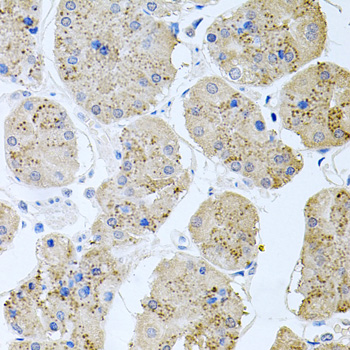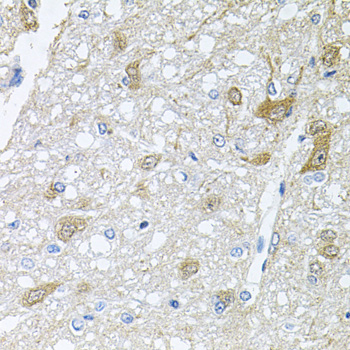Cell Biology Antibodies 10
Anti-RAPSN Antibody (CAB6716)
- SKU:
- CAB6716
- Product Type:
- Antibody
- Reactivity:
- Human
- Reactivity:
- Mouse
- Reactivity:
- Rat
- Host Species:
- Rabbit
- Isotype:
- IgG
- Antibody Type:
- Polyclonal Antibody
- Research Area:
- Cell Biology
Description
| Antibody Name: | Anti-RAPSN Antibody |
| Antibody SKU: | CAB6716 |
| Antibody Size: | 20uL, 50uL, 100uL |
| Application: | WB IHC |
| Reactivity: | Human, Mouse, Rat |
| Host Species: | Rabbit |
| Immunogen: | Recombinant fusion protein containing a sequence corresponding to amino acids 1-353 of human RAPSN (NP_116034.2). |
| Application: | WB IHC |
| Recommended Dilution: | WB 1:500 - 1:2000 IHC 1:50 - 1:100 |
| Reactivity: | Human, Mouse, Rat |
| Positive Samples: | B cells, Mouse skeletal muscle, Mouse brain, Rat skeletal muscle, Rat brain |
| Immunogen: | Recombinant fusion protein containing a sequence corresponding to amino acids 1-353 of human RAPSN (NP_116034.2). |
| Purification Method: | Affinity purification |
| Storage Buffer: | Store at -20'C. Avoid freeze / thaw cycles. Buffer: PBS with 0.02% sodium azide, 50% glycerol, pH7.3. |
| Isotype: | IgG |
| Sequence: | MGQD QTKQ QIEK GLQL YQSN QTEK ALQV WTKV LEKS SDLM GRFR VLGC LVTA HSEM GRYK EMLK FAVV QIDT AREL EDAD FLLE SYLN LARS NEKL CEFH KTIS YCKT CLGL PGTR AGAQ LGGQ VSLS MGNA FLGL SVFQ KALE SFEK ALRY AHNN DDAM LECR VCCS LGSF YAQV KDYE KALF FPCK AAEL VNNY GKGW SLKY RAMS QYHM AVAY RLLG RLGS AMEC CEES MKIA LQHG DRPL QALC LLCF ADIH RSRG DLEL SQLK LHCL SESI YRSK GLQR ELRA HVVR FHEC VEET ELYC GLCG ESIG EKNS RLQA LPCS HIFH LRCL QNNG TRSC PNCR RSSM KPGF V |
| Gene ID: | 5913 |
| Uniprot: | Q13702 |
| Cellular Location: | Cell junction, Cell membrane, Cytoplasm, Cytoplasmic side, Peripheral membrane protein, cytoskeleton, postsynaptic cell membrane, synapse |
| Calculated MW: | 39kDa/46kDa |
| Observed MW: | 43kDa |
| Synonyms: | RAPSN, CMS11, CMS4C, FADS, RAPSYN, RNF205 |
| Background: | This gene encodes a member of a family of proteins that are receptor associated proteins of the synapse. The encoded protein contains a conserved cAMP-dependent protein kinase phosphorylation site, and plays a critical role in clustering and anchoring nicotinic acetylcholine receptors at synaptic sites by linking the receptors to the underlying postsynaptic cytoskeleton, possibly by direct association with actin or spectrin. Mutations in this gene may play a role in postsynaptic congenital myasthenic syndromes. Alternatively spliced transcript variants encoding multiple isoforms have been observed for this gene. |
| UniProt Protein Function: | RAPSN: Thought to play some role in anchoring or stabilizing the nicotinic acetylcholine receptor at synaptic sites. It may link the receptor to the underlying postsynaptic cytoskeleton, possibly by direct association with actin or spectrin. Defects in RAPSN are a cause of congenital myasthenic syndrome with acetylcholine receptor deficiency (CMS-ACHRD). A postsynaptic congenital myasthenic syndrome. Congenital myasthenic syndromes (CMS) are inherited disorders of neuromuscular transmission that stem from mutations in presynaptic, synaptic, or postsynaptic proteins. Defects in RAPSN are the cause of fetal akinesia deformation sequence (FADS); also known as Pena- Shokeir syndrome type 1 or fetal akinesia sequence or arthrogryposis multiplex congenita with pulmonary hypoplasia. FADS is a rare condition characterized by decreased intrauterine fetal movement, congenital limb contractures, pulmonary hypoplasia, polyhydramnios and craniofacial abnormalities. Belongs to the RAPsyn family. 2 isoforms of the human protein are produced by alternative splicing. |
| UniProt Protein Details: | Protein type:Ubiquitin conjugating system; Cell adhesion; Motility/polarity/chemotaxis Chromosomal Location of Human Ortholog: 11p11.2 Cellular Component: Golgi apparatus; centrosome; postsynaptic membrane; cytoplasm; plasma membrane; neuromuscular junction; cell junction Molecular Function:ionotropic glutamate receptor binding; zinc ion binding; protein anchor; acetylcholine receptor binding Biological Process: synaptic transmission; positive regulation of neuron apoptosis; synaptic transmission, cholinergic Disease: Myasthenic Syndrome, Congenital, 11, Associated With Acetylcholine Receptor Deficiency; Fetal Akinesia Deformation Sequence |
| NCBI Summary: | This gene encodes a member of a family of proteins that are receptor associated proteins of the synapse. The encoded protein contains a conserved cAMP-dependent protein kinase phosphorylation site, and plays a critical role in clustering and anchoring nicotinic acetylcholine receptors at synaptic sites by linking the receptors to the underlying postsynaptic cytoskeleton, possibly by direct association with actin or spectrin. Mutations in this gene may play a role in postsynaptic congenital myasthenic syndromes. Alternatively spliced transcript variants encoding multiple isoforms have been observed for this gene. [provided by RefSeq, Apr 2011] |
| UniProt Code: | Q13702 |
| NCBI GenInfo Identifier: | 145559521 |
| NCBI Gene ID: | 5913 |
| NCBI Accession: | Q13702.4 |
| UniProt Secondary Accession: | Q13702,Q8TDF3, Q9BTD9, |
| UniProt Related Accession: | Q13702 |
| Molecular Weight: | 412 |
| NCBI Full Name: | 43 kDa receptor-associated protein of the synapse |
| NCBI Synonym Full Names: | receptor-associated protein of the synapse |
| NCBI Official Symbol: | RAPSN |
| NCBI Official Synonym Symbols: | RAPSYN; RNF205 |
| NCBI Protein Information: | 43 kDa receptor-associated protein of the synapse; RING finger protein 205; 43 kda postsynaptic protein; acetylcholine receptor-associated 43 kda protein |
| UniProt Protein Name: | 43 kDa receptor-associated protein of the synapse |
| UniProt Synonym Protein Names: | 43 kDa postsynaptic protein; Acetylcholine receptor-associated 43 kDa protein; RING finger protein 205 |
| Protein Family: | 43 kDa receptor-associated protein of the synapse |
| UniProt Gene Name: | RAPSN |
| UniProt Entry Name: | RAPSN_HUMAN |
View AllClose









